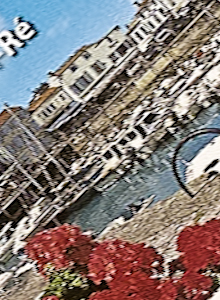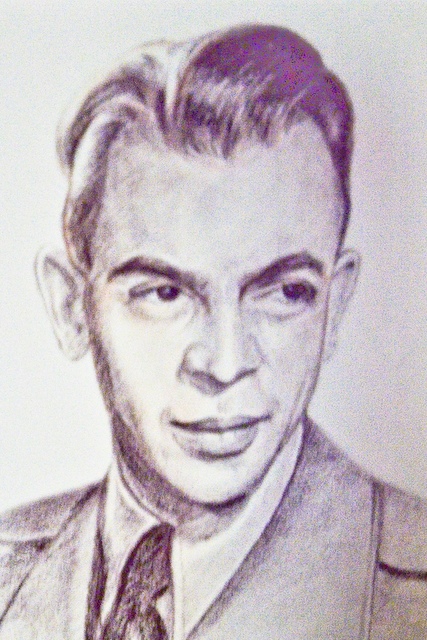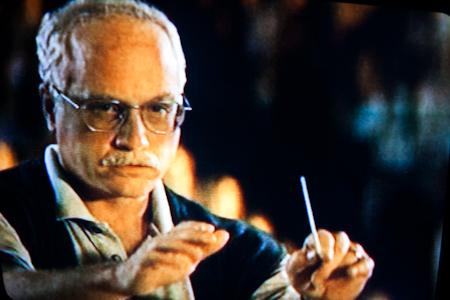| Serge de Gastyne - 82nd Birthday |

July 27, 1930, was a big day for the Lindsay House Family.
(We just didn't live on Earth yet.)
It happened in Paris, France , when a woman artist and writer named Louise gave birth to a boy. He had dark blonde curly hair, which complemented his brown eyes.
The baby's father, Christian, also an artist and writer, named the boy, Serge. Their last name was de Gastyne. Christian's adopted father was the French artist and film maker, Marco de Gastyne.
Somewhere in the family's gene pool there must have been music --
because that's the artistic discipline that Serge later followed.
After a few years, the artist-father left the family, and Louise re-married a poet-writer from Hungary. This man came from a prominent Jewish family in Budapest. Another baby boy joined the family.
The little family's life became hard, as it did for the rest of Europe's people through the ambitions of Hitler and his fellow Nazi aggressors. Louise's husband tried to hide from the Gestapo in Paris, but was arrested on his birthday and soon taken to Auschwitz in Poland, where he later died.
Following the family's coming to America after WWII, Louise wrote a book manuscript called, "Here I Am!",
about the family's experiences during the war and their emmigration to the USA. More than 50 years later the mss. was finally digitized and published in paperback by one of Serge's sons. "Here I Am! is for sale at the Holocaust Museum in Washington, D.C., and can be obtained through this Lindsay House Publishing website.
"Here I Am!", by Louise Norman, is a story celebrating the strength and resilience of the human spirit. "Here I Am!" is family-friendly, and would be an inspiring addition to any family, church or school library. Anyone who appreciates the friendship between Lafayette and George Washington, and the historical admiration for America by Alexis deToqueville, will enjoy "Here I Am!" and will want to share it with others.
After the war, Louise helped surviving Jewish students in Paris to put their lives on track again. After a while she knew that she and the younger boy had to leave France. Serge followed his mother and brother to the United States after a year. He was blessed by his sponsors, a pair of professors at the University of Portland in Oregon, and was given a music scholarship enabling him to graduate - then travel east to pursue study at Eastman-Rochester School of Music in Rochester, New York.
Eastman-Rochester School of Music
In Rochester, the three biggest influences in Serge's musical development were
1) Rochester Symphony conductor Erich Leinsdorf, who hired Serge as a tutor for his children,
2) Howard Hanson, American composer and conductor
3) Organ Professors Katherine Crozier and Harold Gleason
Leinsdorf and Hanson helped shape the young composer's style, and encouraged him greatly. Eventually, seven symphonic works - six of them commissioned - came from Serge's pen.
While at the Eastman School, Serge received "greetings" from both the French and American governments. He chose to enlist in the US Air Force, and was sent for basic training to Sampson Air Force Base, New York.
After basic training and while awaiting reassignment, Serge met the mother-to-be of the six children they eventually shared. The two began their partnership by collaborating on a musical "docudrama" celebrating the 50th anniversary of the Wright Brothers' first successful flight at Kitty Hawk, North Carolina in December of 1903. "Conquest of the Air" was performed twice, with the base band augmented by strings from the USAF Band, chorus, several guest soloists, staged effects and film clips from archives. In two acts, the work told the amazing history of mankind's desire to fly, and the men and women who accomplished and furthered the dream.
In "Conquest of the Air", (written in 1953), the final exclamation sung by The Eternal Flyer is: "The rings of Saturn shall be my runways!"
Imagine the awe, when years later we saw photos of Saturn's rings, taken by the Cassini space vehicle!

Remembering the French island,
Ile de Re
Off of France's west coast city of La Rochelle lies an island called
Ile de Re. It translates in English to, Island of Light. Here Serge's grandparents lived, and while in France, the family had gone there for summer vacations. Love for the seaside life, and boating, was thus deeply engrained in Serge's soul.
Therefore it was not surprising that when the young composer was asked by Thor Johnson, Director of the Cincinnati Symphony, to write a piece for his orchestra's coming season in 1956, the result was a musical memory of Ile de Re. Serge called it, "L'Ile Lumiere" (Island of Light).
(Ile de Re played a large part in the history of the family's dangerous confrontations with the Nazi occupiers. Indeed, it was the last Nazi stronghold in France to surrender to the Allies. The defeated commander had even scheduled the destruction of the island and its inhabitants by bomb emplacements, and the planned disaster was barely averted.)
When the Cincinnati Symphony performed "L'Ile Lumiere" in 1956, it was very well received. In fact, the visiting solo artist for that weekend was Arthur Rubinstein, the world-famous pianist. When Rubinstein asked Serge to write an orchestral piece with solo piano part for him, we were awed. Serge felt intimidated however, and never did fulfill Rubinstein's request.
Where there's a will, and faith, and action, there is a way!

Following the Cincinnati performances of "L'Ile Lumiere", the public relations office of the U.S. Air Force (Serge was by then a member of the USAF Band and Symphony), requested that a taped copy of the performance be sent to the Voice of America for broadcast overseas.
This request was granted by the orchestra and the local musicians' union. HOWEVER,
When Serge requested a copy of the tape for his own collection -- it was his composition after all -- the union said no. ONE union member had black-balled the request. The composer and his family were, shall we say, more than a little upset. Then a plan developed . . .
Serge de Gastyne, by Louise Norman
Dwight D. Eisenhower was by then, President of the United States of America. The White House Chief of Staff and his wife were known to be patrons of the arts, and were personally acquainted with another arts patron who had taken interest in Serge and in his career. A phone call was made connecting the two patrons. The tape recording sent to the Voice of America was "borrowed" by the White House for one week.
From there it was hand-delivered to the composer at his residence, where it was copied. It was then hand-delivered back to the White House, and finally returned to the Voice of America.
The family has that tape recording today. The liveliest movement is called, "Fireworks" and is a model of youthful excitement at a fireworks
display remembered by the French/American musician -- a joy to this day.

Leopold Stokowski was in New York one day when he saw a copy of L'Ile Lumiere on the desk of an influential man at A.S.C.A.P. (American Society of Composers Authors and Publishers). Stokowski contacted Serge and commissioned him to write an orchestral piece for the Houston Symphony to perform
Mr. Holland Takes the Baton
the next season. The tone poem, "Atala", based on a Native American legend, resulted. The family travelled to Texas for the performances and enjoyed some new adventures.
The monumental organ piece, "Cantique de Joie" (Song of Joy), was commissioned by an organist friend who performed its premiere in Paris at the Notre Dame Cathedral in 1971. This piece was just published in July 2012 by Le Plaq'Art in France. Those interested in procuring a copy may contact Lindsay House Publishing. Because "Cantique de Joie" celebrates the joy of God's gift of LIFE, we recommend this majestic organ celebration to our pro-life friends, whatever their religious affiliation.
Send requests for copies of "Cantique de Joie" to
lindsayhouse7@earthlink.net
write Cantique de Joie in subject line
More career information can be seen on wikipedia website.
http://en.wikipedia.org/wiki/Serge_de_Gastyne
About Relationships
Career matters can be overwhelming for people of talent and ambition.
Teacher/student relationships can take precedence over the family ones - a touching film called "Mr. Holland's Opus" comes to mind, and still shots from that film are included here.
For our family, personal events are remembered as well, such as:
Papa introducing the wonders of music, poetry and care for garden plants
First tennis lessons and playing "catch"
Learning to fish and catch crab from Papa's boat
Because Serge became for a while the captain of a ship docked in Alexandria and owned by the Naval Sea Cadet Corps, there were also
occasional trips on the Potomac on that vessel.
Today, July 27, 2012, the Lindsay House Family remembers
Serge de Gastyne -
pianist, composer, author, cadet ship's captain,
gardener, poet, professor and Music Department Chairman
at the Bailey's Crossroads branch of
Northern Virginia Community College -
a witty writer and conversationalist and a man who eventually
overcame great negativity in his life.
He left his legacy through his music,
his writing, his life and
through his children.
Serge was a unique man.
Greatness describes his music
and his American patriotism.
Serge was our husband and father.